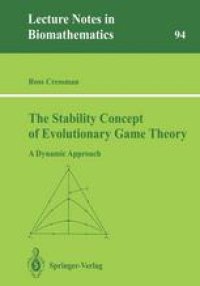
Ebook: The Stability Concept of Evolutionary Game Theory: A Dynamic Approach
- Tags: Mathematical and Computational Biology, Economic Theory, Statistics for Life Sciences Medicine Health Sciences, Ecology
- Series: Lecture Notes in Biomathematics 94
- Year: 1992
- Publisher: Springer-Verlag Berlin Heidelberg
- Edition: 1
- Language: English
- pdf
These Notes grew from my research in evolutionary biology, specifically on the theory of evolutionarily stable strategies (ESS theory), over the past ten years. Personally, evolutionary game theory has given me the opportunity to transfer my enthusiasm for abstract mathematics to more practical pursuits. I was fortunate to have entered this field in its infancy when many biologists recognized its potential but were not prepared to grant it general acceptance. This is no longer the case. ESS theory is now a rapidly expanding (in both applied and theoretical directions) force that no evolutionary biologist can afford to ignore. Perhaps, to continue the life-cycle metaphor, ESS theory is now in its late adolescence and displays much of the optimism and exuberance of this exciting age. There are dangers in writing a text about a theory at this stage of development. A comprehensive treatment would involve too many loose ends for the reader to appreciate the central message. On the other hand, the current central message may soon become obsolete as the theory matures. Although the restricted topics I have chosen for this text reflect my own research bias, I am confident they will remain the theoretical basis of ESS theory. Indeed, I feel the adult maturity of ESS theory is close at hand and I hope the text will play an important role in this achievement.
The book provides a thorough analysis of the theoretical properties of evolutionarily stable strategies (ESS's) in four models of evolutionary biology that are all based on individual selection principles. These models range from the standard frequency-dependent evolutionary game theory model of a single species to more recent models that include density-dependent and/or two-species frequency-dependent interactions. The book is unique in that it emphasizes both static and dynamic aspects of the ESS conditions. Of particular interest to game theorists will be the correspondence between dynamic stability in the biological system and either the Nash equilibrium of non-cooperative game theory or the core solution concept of cooperative game theory. The book is the first to consider, in detail, the game-theoretic effects of contestant information and two-species interactions. Of major significance to evolutionary biologists are the dynamic consequences, on the evolutionary process, of territorial ownership or repeated interactions between the same individuals. The book is intended as a text/reference for students/re- searchers in either discipline(evolutionary biology or game theory) who have a minimum mathematical maturity of a senior undergraduate.
The book provides a thorough analysis of the theoretical properties of evolutionarily stable strategies (ESS's) in four models of evolutionary biology that are all based on individual selection principles. These models range from the standard frequency-dependent evolutionary game theory model of a single species to more recent models that include density-dependent and/or two-species frequency-dependent interactions. The book is unique in that it emphasizes both static and dynamic aspects of the ESS conditions. Of particular interest to game theorists will be the correspondence between dynamic stability in the biological system and either the Nash equilibrium of non-cooperative game theory or the core solution concept of cooperative game theory. The book is the first to consider, in detail, the game-theoretic effects of contestant information and two-species interactions. Of major significance to evolutionary biologists are the dynamic consequences, on the evolutionary process, of territorial ownership or repeated interactions between the same individuals. The book is intended as a text/reference for students/re- searchers in either discipline(evolutionary biology or game theory) who have a minimum mathematical maturity of a senior undergraduate.
Content:
Front Matter....Pages N2-VIII
Introduction....Pages 1-3
Frequency-Dependent Evolution in a Single Haploid Species....Pages 4-30
Frequency-Dependent Evolution in a Two-Species Haploid System....Pages 31-56
Frequency-Dependent Evolution in a Randomly-Mating Diploid Species....Pages 57-76
Frequency- and Density-Dependent Evolution in a Haploid Species....Pages 77-94
Evolutionarily Stable Sets and Contestant Information....Pages 95-122
Back Matter....Pages 123-129
The book provides a thorough analysis of the theoretical properties of evolutionarily stable strategies (ESS's) in four models of evolutionary biology that are all based on individual selection principles. These models range from the standard frequency-dependent evolutionary game theory model of a single species to more recent models that include density-dependent and/or two-species frequency-dependent interactions. The book is unique in that it emphasizes both static and dynamic aspects of the ESS conditions. Of particular interest to game theorists will be the correspondence between dynamic stability in the biological system and either the Nash equilibrium of non-cooperative game theory or the core solution concept of cooperative game theory. The book is the first to consider, in detail, the game-theoretic effects of contestant information and two-species interactions. Of major significance to evolutionary biologists are the dynamic consequences, on the evolutionary process, of territorial ownership or repeated interactions between the same individuals. The book is intended as a text/reference for students/re- searchers in either discipline(evolutionary biology or game theory) who have a minimum mathematical maturity of a senior undergraduate.
Content:
Front Matter....Pages N2-VIII
Introduction....Pages 1-3
Frequency-Dependent Evolution in a Single Haploid Species....Pages 4-30
Frequency-Dependent Evolution in a Two-Species Haploid System....Pages 31-56
Frequency-Dependent Evolution in a Randomly-Mating Diploid Species....Pages 57-76
Frequency- and Density-Dependent Evolution in a Haploid Species....Pages 77-94
Evolutionarily Stable Sets and Contestant Information....Pages 95-122
Back Matter....Pages 123-129
....